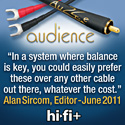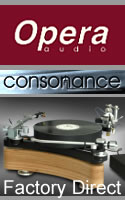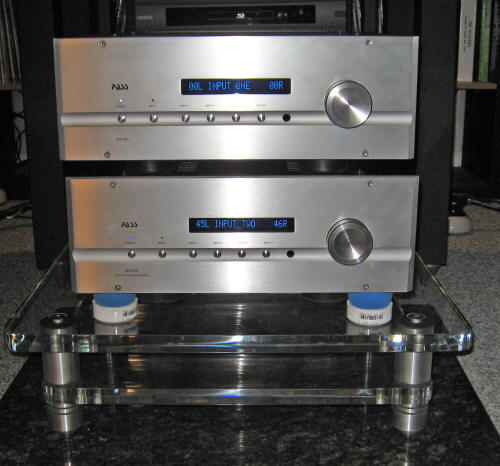|
|
You are reading the older HTML site
Positive Feedback
ISSUE
58
pass labs INT-150 and INT-30A Integrated Amplifiers - Twin Sons from Different Mothers as reviewed by Robert S. Youman
INT-150 top and INT-30A bottom My family and friends like to call me "The Nice Catholic Boy", even at the ripe old age of 56. Not sure why. I would like to think that it’s my quiet, humble, giving personality. Yes, I am the oldest of seven in a typical large 1950s Catholic family (my apologies for the stereotype). Yes, several Nuns with twelve-inch rulers and a Mom with a vacuum cleaner extension cord raised me the old school way. Still, it can be difficult for me to understand. Even my Confirmation party at the age of 12 years was something to remember and consider. In retrospect, it was like the wedding scene in Godfather I. That silk purse that had Pauley panting could have been a scene from my party too. As the money and white envelopes kept rolling in, my Mom’s purse was so stuffed with cash that she finally had to find a large laundry bag to hold it all. The icing on the cake was at the end of the party. My father rolled out a new Schwinn Super Sport ten speed bicycle—all the rage for a select few back then. Heck, anything more than a single speed JC Higgins was considered untouchable in our neighborhood. Between all that money and the bike, I was in heaven. My father took the bag and whispered into my ear that he needed to put it in the bank to keep it safe for the time being. A few months later, thinking about all that cash just sitting idly in the bank finally caught up to me. I wanted a new Wilson A2000 baseball glove—the pride of most major leaguers at the time and still today. This too was a high-end luxury item that typically no kid in my neighborhood could ever afford let alone even know about. Can you tell where this hunger for the very best found its beginning? I asked my Dad if he could take me to the bank so I could take out some money for the glove. I looked up at his face and I will never forget that look of consternation that was reflected back. "What money?" he said. "I used that money to buy your bicycle!" True story. I tell it at virtually every family Wedding and large family event. My Father and I both like to have a good giggle over the past, but there are no hard feelings. That purse of money could never pay for all the monetary and non-monetary support that my Father has given me over the years. I owe him so much more. So what has this all to do with audio equipment? Well, I have always lived by the axiom that when it seems to be too good to be true, it usually isn’t. Over the years, this rule of thumb has held strong through many life experiences. On occasion though, there will be exceptions. I have learned over time that this is certainly the case with Pass Labs. Performance, aesthetics, and value might all seem too good to be true with their products. IMHO, when it comes to Pass Labs, it is generally all true. These folks really know what they are doing. This review is all about two more outstanding products from Pass Labs – each with its own niche and skill set. The Internet Conundrum – X.5 vs. XA.5 There are several threads on the Internet that continue to compare the Pass Labs X.5 and XA.5 amplifier design philosophies and the proper use there of. The X.5 series utilizes a Class A/B design and the XA.5 series utilizes a Class A design. Some of these discussions have evolved into some very heated debates that have spanned several years. As we all know by now, it’s all subjective but some folks are very passionate about their amplifier choices. I can respect that. I have owned the X350.5 and the XA160.5, so I do have some experience on this subject. I can also be very passionate about my amplifiers, as you shall see. Most comments in these Internet threads favor the XA.5 series, but I am a huge fan of the X.5 series when used in the right system. Lets start with two paragraphs from my Pass Labs X350.5 Amplifier review from Positive Feedback Issue 52. This is a direct quote from the highly respected (and all around good guy) Kent English from Pass Labs. The logic presented is an excellent rule of thumb to begin thinking about the right choice. Voltage, current and bias are massaged to accentuate a particular effect. Class A amps are optimized for finesse in handling signal and in general have lower rail voltage and greater current reserves than the identical sized A/B package. Class A/B amps are optimized for maximal wattage and in general have higher rail voltage and correspondingly lower current reserves than the identical sized Class A amplifier. Additional current reserves are beneficial in loads of low impedance and with woofers that require lots of control. Higher voltage is beneficial with speakers that are already well damped or those which have capacitive reactance as a big part of their impedance plot (many panel speakers). If I were taking the over-simplified view of the world, speakers with high "Q" would first audition with class A amps and those of low "Q" would first audition with A/B amps. Speakers of low impedance or high sensitivity tend to get auditioned with the XA.5 amps. Speakers of more modest impedance and low sensitivity tend to get auditioned with the X.5 amps. In other words, there are a number of variables in the decision matrix. That said, these are very much "rule of thumb" and nowhere near "first-principle". The ultimate effect is very much room, material and listener specific. Performance metrics aside, this is a very subjective hobby. For me, both designs can be equally rewarding, but it’s all about system matching with your ears. These days with fewer and fewer dealers, it can be very difficult to borrow or even acquire various amplifiers for a trial in your system. The above words of wisdom on voltage, current, bias, impedance, and dampening factors can help you save a bunch of time and money. The logic is strong that you should take a long hard look at the performance specifications of your speakers before you reach out for possible amplifier options. I can tell you this however, I have tried many speakers with the both the X350.5 and XA160.5, and though this logic held true for most speaker evaluations, it was my subjective ears that helped me define my final thoughts on any specific combination – just as Kent stated. I was pleasantly surprised on many occasions with several speakers that did not fit the above models. Pass Labs INT-150 & INT-30A Integrated Amplifiers
Sorry for all the rambling, but this finally leads me to the following review of the Pass Labs INT-30A (above) and INT-150 Integrated Amplifiers. The INT-30A is a member of the Pass Labs XA.5 series and utilizes a Class A amplifier design rated at 30 watts at 8 ohms. The INT-150 is a member of the X.5 series and utilizes a Class A/B amplifier design rated at 150 watts at 8 ohms. I was not able to test the output of these units, but both ratings seem very conservative based on my experience with similar amps and ratings. Both have the same curb appeal with the same contemporary milled steel faceplate (see attached picture). Both weigh in at 67 pounds. Both have the same inputs: 2 XLR and 3 RCA. Both are designed without a true preamp section but with a simple input selector and buffered volume control. Both have the same remote. And finally, both have the same list price of $7150. Please see the Pass Labs website for additional specifications and product information.
I love the whole idea of integrated amplifiers. No separate components and power supplies. Fewer interconnects, power cords and resonance control devices. Straight wire with gain? The simpler the circuit the better? We shall see. Caveat Emptor Time for my usual buyer beware statements. System synergies and personal taste are critical when evaluating high-end audio products. This review is based on my subjective requirements, my subjective ears and my specific system. These combinations of components are only a few data points of many that exist out there. For further insight into my personal biases, check out the "Meet The Writers" section of Positive Feedback Online. Please consider my comments and analysis appropriately. System For this review, other than what is listed in my system, I used the following components in addition to the two integrated amps.
Two Data Points - Sonus Faber Amati Anniversario & Vienna Acoustics The Music The Sonus Faber Amati Anniversarios and Vienna Acoustics The Music have two distinct flavors of sound performance based on unique cabinet, driver and crossover designs. Both retail in the $28 to $30K range and both are similar in size and weight though The Music is slightly taller and heavier. Efficiency ratings are also fairly close in the 90 to 92 db range for sensitivity. Please see the Sumiko and Vienna Acoustics websites for additional specifications.
In my opinion, the Amatis can be extremely extended and open, but have a very romantic rich sound at all frequencies. Set up correctly, their performance reminds me of another Italian superstar - Sophia Loren. Sexy, rounded and approachable even with poorly recorded material. With the wrong amplifier, these speakers can sound like chocolate—too dark and too slow. The Music is an Austrian thoroughbred of a different color. I find them to be extremely neutral yet fast and detailed. The sound stage can be much wider and deeper than many speakers in this price class. They do not have the addictive midrange bloom or bass weight and slam of the Amatis. In most cases, I prefer them with tubes as some solid state amplifiers can easily push their sound from neutral to white on certain material. Listening Both integrated amplifiers were burned in with over 1000 hours of continual music through the EMM Labs CDSA-SE CD/SACD Player. For whatever reason, the INT-150 took much longer than the INT-30A to finally lock in. I only mention this because I have read some mixed reviews on the INT-150 that in my opinion might have needed additional time to burn in properly. Please be patient with this model before making your final evaluations. I really took my time with this review. Though I listened to hundreds of CDs and SACDs over several months, I want to focus on two specific CDs and two specific tracks from each to describe what I was hearing. Greg Brown – The Poet Game (Red House Records) Poet Game is my favorite Greg Brown release. Greg is classified by some as a folk singer yet his creative output spans several genres including poetry, blues and plenty of good old rock n roll. All auditioning was done with the CD version, which is an incredibly natural and dynamic recording. The LP is even better. Track 6 "Jesus and Elvis" is a simple acoustic recording with Greg and an accompanist on guitar. I always listen for the same things on this cut: the tone and texture of Greg’s voice and the tone and texture of his acoustic guitar. With the Amati and INT-30A, you can really hear the growl and weight of Greg’s howl. Not quite the sand paper feel of Tom Waits, but I’m guessing that this guy likes his cigarettes and whiskey. A unique voice with unique challenges for proper reproduction. Of all the iterations, this pairing consistently provided the most seductive combination of bloom and detail in the midrange when listening to male and female vocals. Substitute the INT-150 and you still get most of the drama and allure but the spotlight is slightly turned down. If midrange is your top priority, it’s hard to beat the INT-30A with either speaker. Acoustic guitar on The Music/INT-30A combination was clearly the most realistic and exciting. The added weight and texture of the INT-30A provided leading and trailing edge harmonics that were spectacular on The Music. Solid state can sometimes rob acoustic guitars of their proper timbre and sheen. This pairing nailed it without compromise. Substitute the INT-150 and you can get a little too much of a good thing.
On the other hand, combine the INT-150 (above) with the Amati and you are back to near nirvana for the same reasons. Frustrating, but isn’t this why we love this hobby so much? Track 4 "Ballingall Hotel" is a wonderful blues piece with some electric bass that will really rock your socks off in the right system. Slam, detail and weight were frighteningly real on the Amati /INT-150 combination. The CD insert did not include a description of all the stage equipment and instruments, but this has got to be one of the nastiest Marshall tube amplifiers ever driving an electric bass guitar. Raspy, throaty and resonant are three words that come to mind. Substitute the INT-30A and you gain some warmth and roundness with slightly less slam. Still impressive by all standards. The Music and INT-150 pairing provided even more slam and detail though not quite as real to my ears. If bass performance is your top priority, my preference would be the INT-150 with either speaker. Tight, tight and more tight. Dead Man Walking – Movie Sound Track (Columbia) Lately, I have been listening more and more to movie sound tracks. Some of the most creative interpretations of traditional music genres and new experimental music (both acoustic and electric) continue to flow through this pipeline. One outstanding example for both sound quality and performance is the Dead Man Walking Movie Soundtrack on CD. Again, the LP released by Classic Records sounds even better. Content includes a scrumptious amount of variety in music genre, artists and instruments. We are talking Bruce Springsteen, Lyle Lovett, Johnny Cash, Suzanne Vega, Steve Earl, Patti Smith, Tom Waits, Mary Chapin Carpenter and on and on. Wonderful stuff. Track 12 "The Long Road" produced by Ry Cooder and sung by Eddie Vedder and Nusrat Fateh Ali Khan is an excellent example of New World Music. Beyond the unique vocal pairing of Vedder and Kahn, we have a range of instruments including the Tombak, Dumbek, Tabla, Harmonium, Electric Guitar and Acoustic Guitar. The Music/INT-30A combination provides a wonderful level of PRAT beyond all other pairings – fast, rich and detailed. Soundstage is well beyond the speakers in all directions. Instruments are locked in and easy to point to. So many things are happening at once that you might expect plenty of smearing and hidden detail – especially on CD. Not the case here. As all the instruments kick in together, you can still hear the vibrations on the Tabla as the leather skin is struck again and again. At the same time, when the Harmonium enters I got a slight chill down my backbone as it clearly stood in space right in front of me. Impressive. Substitute the INT-150 and you get a minute downward adjustment in harmonics and texture, but you gain additional soundstage depth and breadth. The Amati/INT-150 pairing is a very close second with additional warmth and negligibly less speed and detail. Track 2 "In Your Mind" produced by Ry Cooder and performed by Johnny Cash has a superb quality of sound that I wish all Johnny Cash recordings might have. The Ry Cooder production values play a significant role in the emotion and communication of the music. As Johnny begins his lamenting on death, we get another great test for vocal quality. Except for the recent Rick Rubin produced CDs on the American Recordings label, we have never heard Johnny Cash sound like this before. Again, the INT-30A brought out the very best in his unique voice for both speakers. You can tell that this is an older man who has lived a life like few others. Vocal inflections and textures are eerily real. Johnny is in the room with you. This track is also an excellent test for PRAT, soundstage and proper harmonics. Acoustic guitar, acoustic bass, mandolin, and piano each have their moments. Someone seems to be knocking on a door to the right of stage when the song begins. You are startled as the knocks jump out at you unexpectedly. This one is a close call between the Amati/INT-150 and The Music/INT-30A combinations. With both, these instruments are clearly defined with a natural tone and timbre. Flip flop the amps on both speakers and those knocks take a step back into the background. Piano and mandolin for example, now sound like recordings instead of close to the real thing. Summary and Conclusions The basic premise that began this review was the following. One should always consider both your component specifications and your subjective listening biases before considering an amplifier match for your speakers. The former is an excellent first step in the process to save time and money. The later is highly recommended before making your final decision. I have to chuckle. Here in Chiciago, Theo Ebstein was just hired as our new GM for our beloved Chicago Cubs. No need to go into our 100 years of non World Series appearances and our yearly woe and misery. What is interesting is that Theo was hired for his experience and reputation for a similar process as stated above. Theo is the leader of a new wave of baseball executives who believe in combining both Sabermetrics (player performance statistics) and subjective scouting when evaluating and selecting players. Both are now considered equal in importance. After bringing two World Series Championships to Boston (the Red Sox had a similar history as the Cubs), we here in Chicago are all keeping our fingers crossed. Realistically, we know that it will not be as easy as matching speakers and amplifiers. My focus here has been more on the subjective listening part of the process and the evaluation of two integrated amps with significantly different designs and specifications. For this evaluation, I have also used two speakers with significantly different designs and specifications. The INT-30A added a lovely touch of warmth to the midrange and additional harmonic texture to the high frequencies of The Music. Speed and detail were not compromised. Bass performance was superb but I have heard even better when used with more powerful amplifiers and more current. I prefer a marginally tighter sound with more slam. Even with that conservative estimate of 30 Class A watts, I could still crank these babies up with no apparent distortion even with the most demanding rock and electronic music. The INT-30A has more headroom than you might think. When substituting the INT-150, The Music sounded like a different speaker. Immediately I noticed what seemed like another octave of bass. Midrange bloom took a step back but was still very good by all standards. Highs were still fast and detailed, yet much leaner. When paired with the INT-150, the Amatis sounded just wonderful. Still rich and sexy, but with speed to burn. I was concerned that the Amati midrange magic might be compromised, but the additional detail and a slightly less lush output seemed more natural to my ears for these speakers. Pace, rhythm and timing (PRAT) were all dialed up to a new level of performance for the Amatis. Highs were extremely exciting but not overwhelming. Bass was tight and textured. Soundstage depth and width seemed much larger. The Amatis did the disappearing act like never before. When substituting the INT-30A, the change was not as dramatic as the change it made with the The Music. Could the Amatis be easier to drive? The midrange drama was still there in spades. Slightly darker, but no chocolate issues here. Highs were still fast and detailed. Symbols had more of a metal sound than the trailing edge. Bass was the big surprise. I expected the additional roundness and weight, but slam and speed were only slightly affected. Not quite as tight, but still very acceptable. It quickly became very clear that neither integrated amp was going to be the best match for both speakers. Again, all of this is very subjective, but for my ears I can conclude the following. The best combinations for overall sound performance were The Music/INT-30A and Amati/INT-150 pairings. Both combinations proved to be extremely synergistic, exceeding the performance of many solid state and tube separates at two to three times the price. I could live with either combination. Heck, I could die and go to heaven with either combination. Wish List Having assessed all of the above, I have a wish list for a new product from Pass Labs. I have heard through the grapevine that Nelson Pass has only just recently expressed his love for integrated amplifiers. Separate chassis with dedicated circuits, transformers and power supplies obviously do have some logic and value for better sound, but maybe the success of these two products will motivate him to charge forward. How can you ignore the savings to the customer on interconnects, power cords and resonance control devices when using integrated amplifiers over separate components? These saving could be used elsewhere to upgrade a system. How can you ignore the better integration and improved voicing by eliminating a subjective choice of interface between preamp and amplifier? If a designer like Mr. Pass wants to truly guarantee that his vision for the sound of his components are not compromised by all of this complexity, why not go integrated? Some say, that once you go integrated you never go back. What I’d like to see is a hybrid with the midrange performance of the INT-30A and the bass performance of the INT-150. These variables are clear. For the highs, I prefer the speed and detail of the INT-150 but I can understand that some might shine to the timbre and texture of the INT-30A. I can live happily with either. Give me 150 to 200 watts, add one of those sexy blue dials, throw in the Pass Labs XP-15 phono preamplifier and fit it all in one box. Folks, we have a winner and new champion!!! I know that the need for space to accommodate additional circuits, power supplies and transformers make this a very tough challenge. Heaven knows how something like this might be appropriately priced out to make it affordable and attractive for the consumer yet profitable for the manufacturer. I am a big believer in Pass Labs, so maybe it can happen. Like a World Series Championship for the Cubs, I can still dream can’t I? Robert S. Youman
INT-150 Integrated
INT-30A Integrated
Pass Labs
Vienna Acoustics
Sumiko Audio (Sonus Faber) Note: "Twin Sons Of Different Mothers" is the title of a 1978 record by Dan Fogelberg.
|










